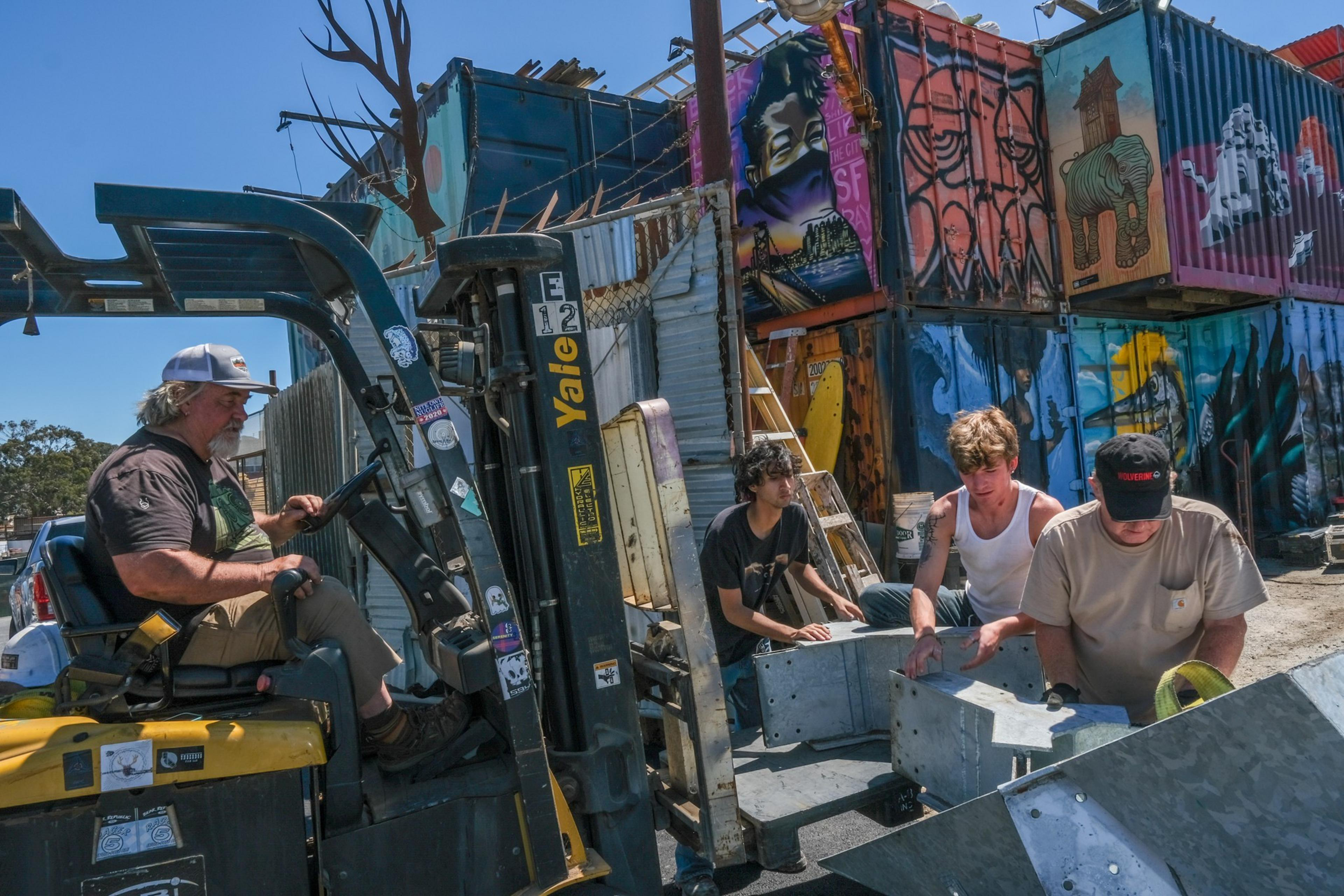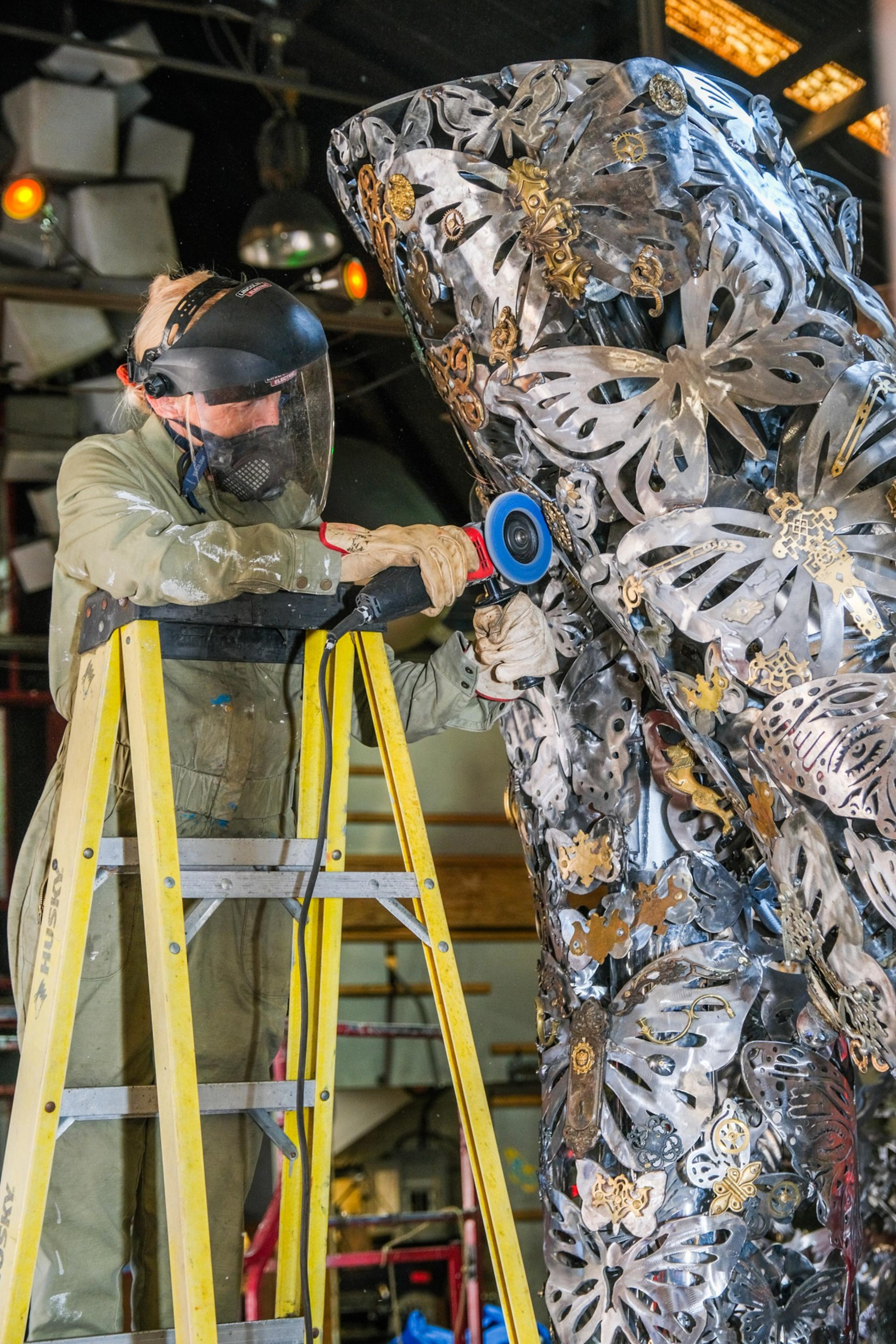I poked my head into the entrance of Box Shop, an industrial arts studio in Hunters Point lined with mural-adorned shipping containers and all sorts of whimsical odds and ends, looking for Charlie Gadeken.
He zoomed up from the back on what can best be described as a lime-green motorized loveseat. “Jump aboard,” he said, before pressing his joystick forward for an impromptu tour of the artistic center he founded and to which he has dedicated the last quarter-century of his life.

It was the week before Burning Man, and the space was a cacophony of sounds: the harsh buzz of welding torches, the rhythmic pounding of hammers and mallets, the high-pitched whir of saws shearing through metal.
Most of the dozen or so people at the studio on a recent weekday afternoon were hard at work on “Release,” a 30-foot sculpture of a woman made from dozens of cutout metal butterflies emerging from a mosaic porcelain chrysalis.
“This is the last industrial collaborative art studio in the city of San Francisco,” Gadeken said, as we averted our eyes from the blinding light of artists welding items onto the installation. “This is a freak garden. We foster and nurture the freak.”
But this era of the Box Shop, which has helped bring hundreds of slightly absurd dreams to life — from an anarchist coffee shop to a giant, fire-breathing serpent — is coming to a close. The Box Shop, which has around 100 artist tenants, will vacate the space by next March.
Rather than mixing media and materials, as he does in his artistic work, Gadeken has had to cobble together a mix of grants, federal Small Business Administration loans, donations, personal finances, and crossed fingers to reopen the center in a new location as Box Shop 2.0.

“We need a place where this art can just stay forever, and nobody can ever kick us out,” Gadeken said. “The goal is to finally make a responsible art that is self-sustaining so we can make this large-scale public art that we do.”
By the skin of his teeth, Gadeken has raised most of the $9 million needed to buy a Bayview warehouse that can function as the art center’s new home.
One major contributor to the survival efforts was state Sen. Scott Wiener, who managed to secure $1.7 million in state funds to help Gadeken purchase the new facility.
But millions more are necessary for the build-out, including the transport of myriad shipping containers (the shop’s eponymous boxes) to the new space. The Box Shop has launched a capital campaign (opens in new tab) to help cover the cost of construction.
“This is like hundreds of people losing a home,” artist Amanda Strong said. “Even if you’ve never picked up a tool before, we will help you, we will train you, we will guide you.”
The trouble started brewing in 2020. The city unveiled plans for the adjacent India Basin Waterfront Park (opens in new tab) that swallowed up the arts center. Revised drawings pulled the park back directly to the Box Shop’s location at 951 Hudson St., but the writing was on the wall.

Three months later, Gadeken said, his landlord refused to sign an expected lease extension. Lawyers, negotiations, and a 35% rent increase bought the Box Shop three and a half more years at the current location. The $14 million asking price for the land was out of Gadeken’s price range.
Gadeken freely admits he’s not the business type; he’s better known for his large-scale sculptures and installations like “Entwined,” which consists of Africa-inspired metal trees with dozens of light cubes fruiting off the branches.
The move to Box Shop 2.0 will be accompanied by changes to the organization itself, including the creation of a nonprofit arm to supplement the tiny for-profit operation that earns revenue from tenants renting space and using the array of heavy equipment, like laser cutters and industrial-size metal grinders.
Sam Cooler was closely examining her interactive art project, in which a custom circuit board programs shooting flames from a device that can be controlled by a series of attached pulleys.
“A place where you can have teams of amateurs using tools like these is extremely rare,” Cooler said. “The Box Shop is one of the last places. I asked people in the know, and they said if you asked me 10 years ago, I’d have a dozen names. Ask me now, and I have three.”
As he prepares for the move, Gadeken finds it hard not to feel nostalgic. When he arrived 20 years ago, the neighborhood was dangerous and desolate. He recalls hiding behind large sheets of metal when gunshots would ring out.
But as the Box Shop expanded its roster of artists, he observed the slow decline of places where industrial art can be made in the Bay Area, due in large part to the rising costs of living and housing. There’s a bitter irony, he said, now that the city is relying on arts and culture as a way to revitalize its economy.

“There’s a lot of people that come to San Francisco that never get to experience it, right? They can see the myth of it, but they’re never truly in it,” Gadeken said. “The weirdos are all over San Francisco; it’s still a weird place. People are here where you can be yourself, and people are gonna love you for it.”
As if on cue, a man came wandering in from the street. He said he owns a nearby welding company and was attracted by the Box Shop’s industrial arts vibe and colorful murals.
“What’s going on, and how do I get involved?” he asked.
“We’re an arts studio,” Gadeken replied. “Go make some art.”
